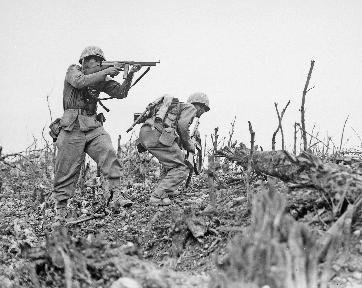Quiz Answer Key and Fun Facts
1. Winning the Battle of the Atlantic was crucial to Britain's continuation of the war, as it allowed supplies to be brought from America. The first nine months of the war were relatively easy for Britain in the Atlantic due to their naval superiority and the fact that Germany did not have enough U-boats to make any sort of serious impact on Britain's supply routes. On top of this, British ships were able to destroy nearby U-boats which may have been a threat. How did they do this?
2. Britain also fitted its ships with Sonar, allowing U-boats to be detected underwater. What was this Sonar known as?
3. Doenitz (the German naval commander) realised the potential of the U-boats and so their number increased. Also, after the fall of France Germany was able to use French ports and so could spend longer in the Atlantic. U-boats also began using new tactics, the result being the increased amount of shipping damaged and the reduction of supplies to Britain. One way U-boats did this was by attacking in groups, what was this known as?
4. This disastrous period, starting in the summer of 1940, lasted until June 1941. However, Britain also changed its tactics. What was the name of the radio frequency detector used to intercept messages between U-boats, thereby avoiding them?
5. Another way Britain reduced its losses was by increasing available protection to convoys. One way they did this was by making a deal with the USA in September 1940 by which Britain received more ships capable of providing this protection. What was this deal known as?
6. Britain extended its advantage in the Atlantic in May 1941, when a sinking U-boat was boarded by British sailors who obtained the German naval enigma codes. This allowed Britain to correctly determine when attacks were coming and was therefore able to avoid them. What name was given to this information?
7. The Battle of the Atlantic was very much a see-saw of success as Germany regained the upper hand. By July 1942 Doenitz had almost 300 U-boats, which were capable of staying at sea for longer periods of time. British shipping losses also rose again due to German attacking of convoys in the middle of the Atlantic, rather that near ports, due to lack of air protection. What was this area in the middle of the Atlantic, without air cover, known as?
8. Germany began to crack British naval codes. Moreover, Doenitz became suspected that Britain was cracking the German naval code and so changed the enigma code by adding a fourth wheel to the machine. What was the new code known as?
9. Finally, Britain again got on top of Germany in the Atlantic as the new naval code was broken, and adopting a more aggressive stance towards the threat of the U-boats. Who encouraged this aggressive attitude?
10. The decisive point of the Battle of the Atlantic was the entry of the USA into the war. America offered a seemingly unlimited supply of resources to be used on land and at sea. One of the major contributions America made to the Battle of the Atlantic was their construction of a bomber plane fitted with radar, searchlights and machine guns which offered constant air protection to convoys. What was the name of this plane?
Source: Author
doublemm
This quiz was reviewed by FunTrivia editor
bloomsby before going online.
Any errors found in FunTrivia content are routinely corrected through our feedback system.

